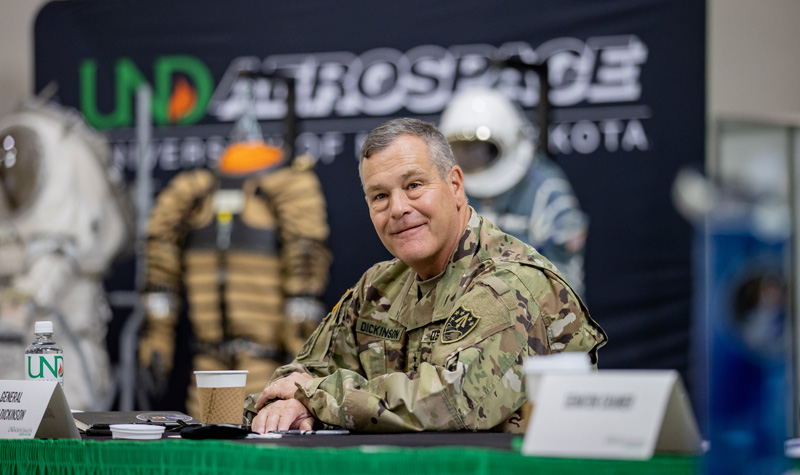University of North Dakota Department of Defense DEPSCoR FY2006 Award
Press Release from the School of Engineering and Mines, University of North Dakota.
For Immediate Release
Dr. Richard R. Schultz, Associate Professor & Chair of Electrical Engineering at the University of North Dakota, was recently awarded $457,985 from the U.S. Army Research Office for a three-year project entitled “Real-Time Super-Resolution ATR of UAV-Based Reconnaissance and Surveillance Imagery.” Unmanned Aerial Vehicles, or UAVs, are robotic airplanes used for military and homeland security intelligence gathering, especially to capture surveillance images and to relay communications from point-to-point. Dr. Schultz’s research project is dedicated to image processing and analysis, in order to see details more sharply in video captured by UAV imaging payloads and to help with automatic target recognition (ATR) and tracking.
In movies about national security such as Patriot Games and Enemy of the State, it seems rather easy to zoom in on people, buildings, and vehicles found in satellite and airborne surveillance images. However, if you use the magnification tool found in any image processing software package to zoom way in on a picture from your digital camera, you will see just how blocky the pixels really are. By exploiting the movement between multiple frames in a video sequence, it is possible to extract extra details from digital video frames that are not visible within any single digital camera picture. The movement of the UAV payload imager with respect to the ground can be exploited in this very same manner to enhance surveillance and reconnaissance video footage.
In March 2006, the Department of Defense announced that a total of $11.5 million would be awarded to 22 academic institutions in 17 states through the FY2006 Defense Experimental Program to Stimulate Competitive Research (DEPSCoR), specifically to perform research in science and engineering fields important to national defense. Twenty-five projects were competitively selected under the FY2006 DEPSCoR program, which is designed to expand research opportunities in states that have traditionally received the least amount of federal
— MORE — support for university research. Academic researchers in Alaska, Arkansas, Delaware, Hawaii, Idaho, Kansas, Kentucky, Maine, Montana, New Hampshire, Nebraska, Nevada, North Dakota, Oklahoma, Puerto Rico, Rhode Island, South Carolina, South Dakota, Tennessee, the U.S. Virgin Islands, Vermont, West Virginia, and Wyoming were eligible to receive awards under this competition. The Air Force Office of Scientific Research, the Army Research Office, and the Office of Naval Research solicited proposals using a defense-wide Broad Agency Announcement. The announcement was published on the Internet and accessed by the DEPSCoR state committees, which solicited and selected projects for each state’s proposal. In response, 21 state proposal packages consisting of 103 projects were submitted, requesting approximately $55 million.
From a more technical viewpoint, this DEPSCoR award to the University of North Dakota will investigate feature-domain super-resolution image reconstruction with model-based constraints as a robust and real-time automatic target recognition algorithm for reconnaissance and surveillance imagery captured by airborne sensors flown by Unmanned Aerial Vehicles. Pixel-domain super-resolution is capable of extracting additional visual details from electro-optical (EO) and infrared (IR) video feeds that are not observable in any one frame through the integration of several frames registered with respect to a target-of-interest. However, super-resolution algorithms that rely on pixel-domain constraints are generally unsuitable for ATR because they are severely limited in magnification power, highly computational, and extremely sensitive to clutter, occlusions, noise, and registration errors. To overcome these limitations, model-based constraints will be generated by projecting CAD models and digital images of known military targets under surveillance, such as aircraft, armored personnel carriers, and combat vehicles, into a much lower-dimensional “target-space” using principal components analysis. By utilizing these “eigentargets,” super-resolution carried out in this low-dimensional feature-domain will be capable of quickly detecting and identifying a target that appears in only a small fraction of pixels within several video frames, as well as magnifying the visual data by much greater than 10x.
# # #
About UND SEM: The UND School of Engineering & Mines (SEM) offers fully-accredited undergraduate engineering programs in chemical, civil, electrical, geological, and mechanical engineering, with additional program concentrations in computer science and aerospace. Graduate degrees at the Master of Science level are also offered in all of these disciplines, in addition to the Ph.D. in Engineering. The SEM emphasizes its undergraduate teaching mission while supporting a wide variety of innovative research activities in the areas of distance learning, engineered surfaces, renewable and sustainable energy, and unmanned aerial vehicle payload and sensor development.


